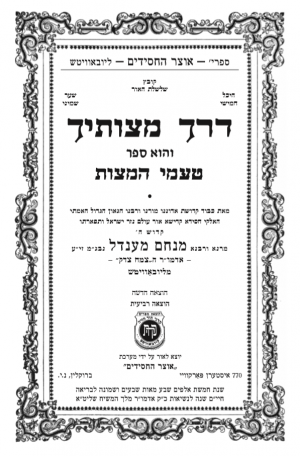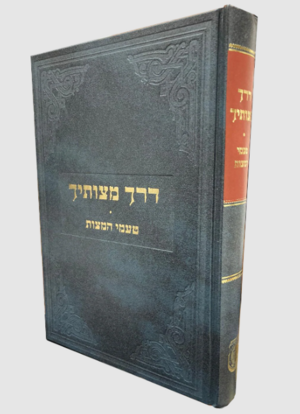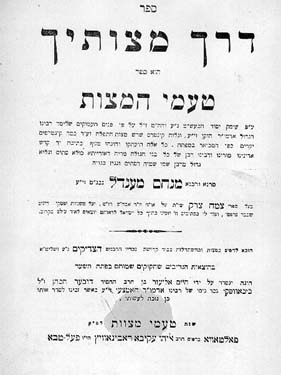Derech Mitzvosecha



Derech Mitzvosecha, also known as Sefer Taamei HaMitzvos, is a work of Chassidus focusing on the reasons for the mitzvos, written by the Rebbe the Tzemach Tzedek. The book was first published by A.E. Rabinowitz printing in Poltava in 1911 and is currently published by Kehot.
The book is divided into three parts: "Taamei HaMitzvos", "Shoresh Mitzvat HaTefillah", and "Articles and Additions".
"Derech Mitzvosecha Part Two", known as 'Shoresh Mitzvat HaTefillah', deals with explanations of words in prayer and is not connected to the first part. This section was first published in Poltava in 1911.
First Part[edit | edit source]
Taamei HaMitzvos[edit | edit source]
The first part of the book is called "Sefer Taamei HaMitzvos" and includes explanations on some of the 613 mitzvos, based on the maamarim of the Alter Rebbe - mostly according to the transcripts of the Mitteler Rebbe.
The book was written in a style suitable even for those who find it difficult to study Chassidus, as the Rebbe writes: "Regarding guidance in learning Chassidus... it is appropriate to obtain Kuntres U'Maayan and Sefer Derech Mitzvosecha by the Tzemach Tzedek, as their style is more suitable for one who is not so accustomed to Chassidic texts."
For most mitzvos, the Tzemach Tzedek noted at their beginning their enumeration in the "Minyan HaMitzvos" of Sefer HaChinuch, and for some he also added the explanations of the mitzvos from Sefer HaChinuch and the Rambam's Sefer HaMitzvos.
This section is built on the level of Sod from the Zohar, Taamei HaMitzvos from the Arizal's Likutei Torah, Pri Etz Chaim, Sefer Otzros Chaim, and more.
Second Part[edit | edit source]
Shoresh Mitzvat HaTefillah[edit | edit source]
This lengthy section consists of 49 chapters dealing with explaining the matter of prayer and Krias Shema according to Kabbalah and Chassidus
The Tzemach Tzedek wrote this section while his grandfather, the Alter Rebbe, was still alive. When the Tzemach Tzedek's wife gave these writings to the Alter Rebbe without her husband's permission, he demanded a din Torah with her before the Alter Rebbe and wanted to divorce her. He was only appeased when his grandfather established a new chavrusa with him in learning.
In this section, the author extensively discusses resolving the apparent contradiction between the Sifri's interpretation of the verse "Who is like Hashem our G-d whenever we call upon Him" - "to Him and not to His attributes" - and the prayers that address G-d with names that allude (according to Kabbalah) to specific divine attributes (meaning, to G-dliness as it descended and was condensed in certain parameters relevant to the limited worlds). For example, the name "E-l" alludes to Chesed, the name Elokim alludes to Gevurah, etc.
Articles and Additions[edit | edit source]
Additional articles printed from the Tzemach Tzedek's handwriting. This section also includes a summary the Tzemach Tzedek wrote on Sefer HaTanya and a collection of the Tzemach Tzedek's explanations in Kabbalah and Chassidus from his letters.
In recent editions of the book (starting from the 1953 edition), an index of topics, chapter headings from the Tzemach Tzedek's biography, and references to various books containing explanations of Taamei HaMitzvos not explained in this book were added. These three sections were edited by the Rebbe.
Annotated Edition[edit | edit source]
In recent years, the organization Toras Chabad L'Bnei HaYeshivos (published by Mayanosecha) has been publishing the book with extensive and clear commentary. As of 2020, four volumes of "Derech Mitzvosecha - HaMevuar" have been published, completing the commentary on the mitzvos in the book. The next volume in the series will deal with explaining "Shoresh Mitzvat HaTefillah".
The editorial board members working on the commentary are: Rabbi Shneur Zalman Gofin, Rabbi Binyamin Meiri, and Rabbi Eliyahu Kirschenbaum.
Printing History[edit | edit source]
The book was first printed in Poltava, Ukraine in 1911 from the Tzemach Tzedek's manuscript, which he wrote between 1814-1828. The first edition of the book was published by Kopust Chassidim. Kehot published the book in 1946 in Shanghai, where many Temimim students fled during World War II.
In 1953, the book was published in the United States with additions, and in 1991 it was printed for the first time in square letters (until then the book was printed in Rashi script). This edition added numerous sources and references as well as a detailed index of the book. The book was printed again in 1993, 2006, and 2018. In 2021, an edition was published with renewed proofreading, including an index of Geulah and Moshiach and a table of abbreviations.
See Also[edit | edit source]
- Rabbi Yekusiel Green, "Ahavas Yisrael in the Teachings of the Tzemach Tzedek", explained the mitzvah of Ahavas Yisrael from 'Derech Mitzvosecha'.
